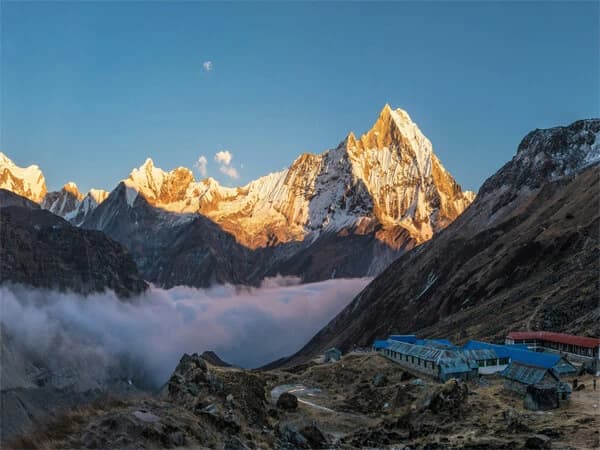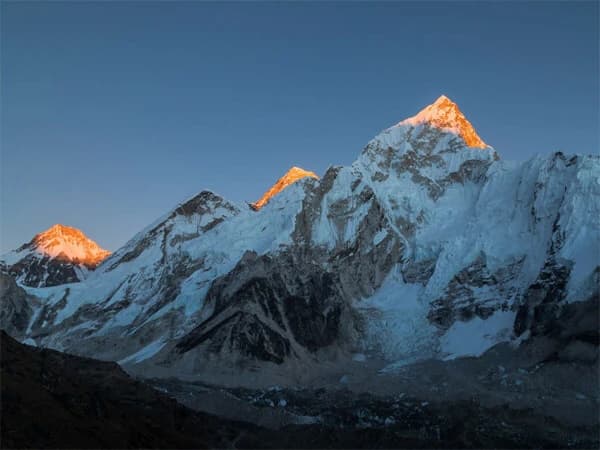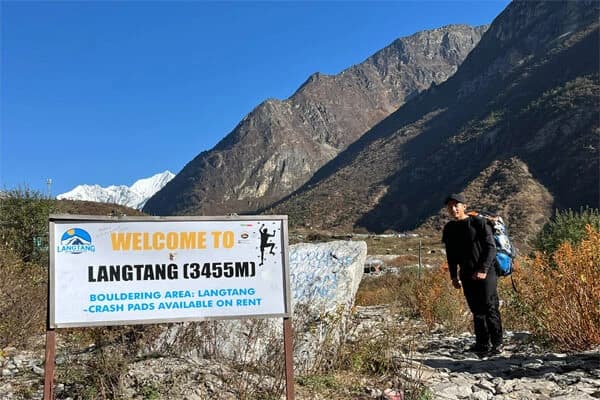The Everest climbing tour is a transformative experience that pushes your inner power, mental strength, and physical boundaries. Many people start their journey to the top of the world with the question, "Why climbing Everest at all?" The response is frequently very personal. Many people aspire to push themselves beyond their limits, while others are motivated by the challenge itself or the excitement of adventure.
This blog will walk you through every crucial aspect of this amazing trekking adventure to Mount Everest. You can find useful, honest information here whether you are planning your first Everest adventure or are just interested in what it takes to stand at 8,848.86 meters. We'll go over the routes, training, dangers, expenses, permits, mountain living, and even the psychological effects of summiting.

To increase safety, the Nepal government implemented new regulations for Mount Everest Expeditions in 2025. Before trying Everest, climbers must now have successfully ascended at least one 6,500-meter Nepalese peak. This guarantees that the harsh circumstances of Everest are only faced by seasoned climbers who have received the necessary training. Climbers must also provide a thorough health report and evidence of valid insurance, per the guideline. These adjustments are meant to respect the mountain, control crowding, and lessen accidents. Climbers and tour operators now have to make more responsible and thorough plans before embarking on this risky but life-altering journey.
The story you write along the route is just as important as raising a flag at the summit when climbing Everest. And this guide is for you if you've ever questioned what's possible while gazing up at the mountains.
The Two Main Routes for Everest Expeditions
The first major choice you must make if you want to climbing Mount Everest is between the North Side (Tibet/China) and the South Side (Nepal). Despite leading to the same top, the two approaches provide somewhat distinct experiences.
South Side Route (Nepal): The Most Popular Expedition Routes
Why South Side of the Mount Everest Climbing used traveler more? Because it provides more choices for rescue in an emergency, is easier to reach, and has greater infrastructure.
- Starting Point: After a thrilling flight to Lukla, the journey continues with a trek through stunning Sherpa settlements including Namche Bazaar, Tengboche, and Dingboche.
- Base Camp Altitude: approximately 5,364 meters.
- Everest Expeditions Route Style: On your journey to the summit, you will pass through four camps (Camp I through Camp IV). Among the more difficult parts is the infamous Khumbu Icefall.
- Why It is Popular: With more frequent weather reports, knowledgeable guides, and helicopter rescue alternatives in case of emergency, the South route is better supported.
North Side Expedition Routes (Tibet): Remote and Windier
Technically, the North Side is different and quieter. It is typically selected by seasoned climbers seeking an unusual challenge.
- Starting Point: The Tibetan Base Camp will be reached by land.
- Base Camp Altitude: Approximately 5,150 meters (16,900 feet), which is little less than Nepal's.
- Route Style: The last summit push over the Three Steps, rough steps, and fixed ropes are all part of this route.
- Challenges: The weather is more severe, rescue is more difficult, and wind causes oxygen levels to drop.
Which Route Should You Choose?
The South Side via Nepal is typically a better option if this is your first 8,000-meter summit. It is better supported, safer, and more picturesque. The North Side is best suited for experienced climbers with high-altitude experience because it is more remote and difficult.
Best Time to Climb Mount Everest

While you are planning to go Everest Expediton. Selecting the appropriate season is essential for a safe and successful summit because the weather, wind, and visibility can all change drastically in a split second.So Spring season is the best season/time to climbing Mount Everest. Since the weather is generally more steady in the spring or fall, most climbers attempt Everest during these seasons.
Mount Everest Expedition in Spring Season (April to May)
Climbing Mount Everest is most popular in the spring. The heavy winter snow has subsided by April, and a minor increase in temperature has started. Climbers have a better chance of sunny sky, moderate winds, and fewer snowstorms during this season. Just before the summer monsoon starts, in the second or third week of May, the majority of peaks take place.
In the spring, the Khumbu Icefall is typically stable. As hundreds of Sherpas and climbers pitch their tents, the base camp is a hive of activity. The greatest time of year to experience Everest with a busy international population is in the spring.
Mount Everest Expedition in Autumn Season (September to October)
Although it provides an alternative, autumn is not as popular with climbers. After monsoon rains, the weather clears up, bringing with it cooler temperatures and blue skies. Snow conditions can climb more challenging, though, and the mountain is cooler.
One benefit of climbing in the fall is that there are less climbers on the route, which reduces traffic, particularly at the Hillary Step and other small pathways. However, compared to spring, it can be more difficult to forecast stable climbing time.
Mount Everest Expedition in Winter and Summer
For Everest climbing, winter (December to February) and summer (June to August) are regarded as off-seasons. While summer brings avalanches and torrential monsoon rains, winter brings bitter cold and lethal winds. During these months, only very experienced alpinists climb Everest, and even then, very few are successful.
Physical and Mental Preparation
Reaching the peak is only one aspect of climbing Mount Everest; another is surviving the ascent. It is not a hike. Extreme altitudes, erratic weather, and physical weariness are all part of the multiweek journey. Your encounter will be safer and more successful if you are mentally and physically prepared.
Start Early: Training Timeline
Ideally, you should start rigorous training six to twelve months before to your trip. The majority of climbers adhere to a personalized schedule developed with advice from adventure fitness specialists or mountaineering coaches.
A strong Everest preparation strategy consists of:
- Cardiovascular endurance (backpacking, running, etc.)
- Strength training for the shoulders, core, and legs
- Altitude training (using hypoxia masks or, if feasible, high-altitude settings)
- Long hikes that mimic alpine days using weighted packs
Practice with Smaller Peaks First
Gaining experience on lower peaks is highly advised if Everest is your first major climb. To see how their bodies respond to extended trips and high altitude, many climbers make their first attempts to Island Peak, Mera Peak, or Aconcagua.
Mental Strength Is Just as Important
As much as it is a physical struggle, climbing Everest is a mental one. Imagine enduring weeks of subfreezing weather, being away from loved ones, and enduring ongoing physical strain. It is simple to feel hopeless, particularly when altitude sickness sets in when storms impede progress.
To mentally get ready:
- Recognize how to remain calm under pressure.
- Engage in breathing techniques or meditation.
- Imagine difficult circumstances and your reaction to them.
- Recognize that patience and adaptability are necessary for the path.
Even when your body wants to give up, mental toughness may be what keeps you going.
Climbing Mount Everest Permits, Costs, and Paperwork
The Climbing Permit: A Must-Have Document
An official Everest Climbing Permit from the Department of Tourism of the Nepali government is required in order to ascend Mount Everest from Nepal. This is a non-negotiable document that needs to be organized beforehand, usually by your expedition company.
The size of the group affects the permIt is cost $11,000 USD each person during the spring. Most people attend in the spring, while autumn and winter have slightly reduced fees. The procedure is different and involves going through the China Tibet Mountaineering Association (CTMA) if you are climbing from Tibet (the north side).
Other Essential Permits and Fees:
- Along with your Everest climbing permit, you will also require:
- Sagarmatha National Park Entry Permit – to enter the park where Everest lies
- Khumbu Pasang Lhamu Rural Municipality Permit – required for the lower Everest region
- TIMS Card (Trekkers’ Information Management System) – may be waived for climbers with climbing permits
These are usually arranged by your tour operator, but It is good to know what's involved.
Mount Everest Expedition cost
Climbing Mount Everest is an expensive goal, so It is important to know the Mount Everest Climbing costs before committing. A typical Everest expedition costs between $35,000 to $70,000, depending on the season, operator type, and degree of support. In the spring, when climbing is most popular, the Nepali government issues a mandatory Mount Everest climbing permit costs $11,000 per person. A few hundred dollars more is needed for additional permissions to enter the Khumbu region and Sagarmatha National Park.
Hiring knowledgeable guides and Sherpas might range in price, but their assistance is essential for both success and safety. A significant portion of the cost also goes for oxygen cylinders, which are essential at very high elevations. Climbers also have to pay for food, tents, ropes, ladders, satellite communication, base camp services, and transportation. If you don't already have it, personal equipment like boots, down jackets, gloves, and goggles can cost several thousand dollars. Additionally necessary is travel insurance that includes high-altitude rescue coverage.
While some firms provide luxury climbs with individual guides and heated tents, others offer more affordable trips with less facilities. No matter what package you select, climbing Everest requires a significant financial and physical investment.
Is Travel Insurance Required?
Of course. You need to have full-coverage travel insurance that includes Trekking and climbing at high elevations (above 6,000 meters), Rescue and emergency evacuation by helicopter, Delays and cancellations of trips, and International medical costs. Verify the policy again to ensure that Everest-specific actions are covered.
Paperwork and Medical Checks
The majority of businesses also need your doctor's recent medical clearance, a signed liability waiver, a valid passport, and passport size photos for permits.
Maintain both physical and digital copies of all documents, and inform your family of their access in case of an emergency.
Choosing a Climbing Operator
Choosing your climbing operator is one of the most crucial decisions you will make when you decide to climb Everest. From how safe you feel on the mountain to how well your body adapts to the altitude, this choice can affect every aspect of your trip. Reaching the top isn't the only goal; how you get there and who helps you along the road are also important.
International vs. local companies
Numerous climbing operators or Expeditions Operator are available for selection. Some are international companies with years of global mountaineering experience. Some are native Nepali businesses that are intimately familiar with every aspect of Everest. International businesses frequently charge significantly more, even though they could have a larger workforce and more luxurious services. However, smaller businesses typically provide more reasonably priced packages, and many of them are equally skilled and knowledgeable.
How do you make a decision, then? Start by examining their safety record. When it comes to summiting, a competent operator prioritizes safety. Inquire about the ratio of guides to clients; ideally, there should be one climbing Sherpa for every two or three customers. In this manner, you receive the assistance you require, particularly when You are worn out or have to make difficult choices at a high altitude.
Inquiring about the number of successful summits they have had recently and the type of evacuation assistance they provide is also a good idea. Do they have bottles of oxygen with them? Do they have satellite phones and radios? In the event of an emergency, will you have insurance or coverage? When your life is on the line, these things are considerably more important than opulent tents or fine dining.
Recommendation for Expedition in Nepal
Nepal Trekking Routes, a reputable local company that provides expertly planned, guided Everest climbing programs, is one operator I heartily recommend. Experienced Sherpa climbers, medically qualified guides, and supportive porters make up their team, which ensures your well-being at every stage. Additionally, they emphasize ethical tourism, which includes respect for the environment, appropriate acclimatization, and fair compensation. Selecting the appropriate operator is important for survival, dignity, and making a memorable experience that you can be proud of, not only for success.
Life on the Mountain: Camps, Acclimatization, and Daily Routine
Climbing Mount Everest involves more than a single, long trek to the summit. It is a careful, gradual journey divided into phases, with the weather, altitude, and your body's response influencing each day. The majority of climbers travel a predetermined path with multiple camps along the way, each one more difficult, colder, and higher.
Base Camp: Your Mountain Home
Your climbing adventure actually starts at Everest Base Camp, which is located at an elevation of about 5,364 meters. For a few weeks, you make it your home. You rest here, get to know your climbing crew, and get ready for the strenuous ascent. Medical facilities, communication systems, and dining and sleeping tents are all present. You will stay here for a few days, getting used to the altitude and doing quick treks to neighboring hills.
Higher Camps and the Rotation Plan
Climbers ascend progressively from Base Camp to the death zone's Camp I (6,065m), Camp II (6,400m), Camp III (7,200m), and Camp IV (7,950m). However, you don't simply go up. You acclimate by ascending to a higher camp and then returning to a lower one according to a "rotation schedule." Your body adjusts to the thin air through this back-and-forth, which also gets you ready for the last push to the top.
Daily Schedule for Everest Climbing
Usually, the day begins early, even before daybreak. After a modest breakfast, you prepare yourselves and proceed cautiously in the direction of the next camp. There are rest periods every 30 to 60 minutes, and the tempo is steady and gentle. Usually, oxygen utilization starts above Camp III. Simple but comforting meals include tea, noodles, and soups. You settle in your tent by the early afternoon to get some rest.
Risks and Challenges
On the mountain, every day is both physically demanding and spiritually potent. You learn to move patiently, respect the environment, and pay attention to your body.
Altitude Sickness: The Invisible Danger
Altitude sickness is one of the main dangers of climbing Everest. The oxygen content in air decreases as altitude increases. Acute Mountain Sickness (AMS), which results in headaches, lightheadedness, and nausea, may result from this. If left untreated, AMS can develop into more catastrophic conditions like HACE (brain edema) or HAPE (fluid in the lungs). For this reason, climbers need several days to acclimate to the elevation. The secret to survival is to pay attention to your body and give yourself time to adjust.
Extreme Weather Conditions
On Everest, the weather is erratic and frequently hazardous. There may be a period of calm followed by snowstorms or strong winds. Above 8,000 meters, the "death zone" is particularly harsh. The wind chill makes it feel considerably colder, and temperatures can fall below -30°C. Before attempting to reach the summit, many climbers must wait for a window of safe weather. Even yet, things can change quickly, so every choice needs to be well thought out.
Physical Exhaustion and Injuries
It takes endurance in addition to strength to climb Everest. Your body is put through its paces during the ascent. Common symptoms include dehydration, frostbite, fatigue, and muscle strain. Even the most basic activities, like eating or walking, can become taxing. Steep, icy slopes can potentially cause falls and slips. This is why It is so crucial to train well before the climb.
Mental Pressure and Decision-Making
Lastly, the mental task is as difficult. Fear, worry, and self-doubt are common among climbers, particularly in the death zone. Making wise choices can save lives. Sometimes the bravest course of action is to go back. Your safety comes first, yet the mountain is always there.
Gear and Packing Essentials
Climbing Mount Everest is not like other treks because of the extreme height, strong winds, and frigid temperatures. Having the proper equipment is important for safety as well as comfort. Your gear and clothes must support your body's ability to withstand the wind, the cold, and the oxygen shortage.
Must-Have Clothing and Personal Items
Layering is essential at high altitudes. To start, use a base layer that wicks away perspiration. Put on an insulating mid-layer, such as a down jacket or fleece. Additionally, a windproof and waterproof shell shields you from the severe Himalayan climate.
To survive in the "death zone," you will require a heavy down suit on summit day. A warm helmet or balaclava, liner gloves, heavy gloves or mittens, thick wool socks, and high-altitude footwear with adequate insulation are also essential. Snow goggles and UV-blocking sunglasses are essential for preventing snow blindness.
Oxygen System and Climbing Equipment
A personal oxygen mask and cylinder system is usually utilized during summit efforts. This is typically provided by your guide service, along with other necessary climbing equipment such as carabiners, ice axes, crampons, helmets, and harnesses.
Sleeping and Personal Care Items
A sleeping mat and a high-quality sleeping bag that is rated for extreme cold are required. Additionally crucial are personal care products including sunscreen, SPF-containing lip balm, wet wipes, hand sanitizer, and basic medication.
What’s Provided by Tour Operators
Tents, cooking supplies, ropes, and occasionally even boots and down jackets are included in the majority of Everest climbing tour packages. To ensure you know what to bring, always ask your operator. The key to wise packing is balance: don't overpack, but be warm and safe.
Sherpas and Local Support Team
Who Are the Sherpas?

An ethnic group known for their extraordinary strength and capacity to survive at high elevations, the Sherpas are indigenous to Nepal's high Himalayas. They serve as climbers' lifeline and are more than just guides. Their in-depth understanding of the terrain, weather, and mountain is crucial for successfully negotiating Everest's hazards.
Their Role
In addition to fixing ropes, setting up camps, and carrying big goods, sherpas frequently take the lead in the most challenging areas. Climbing Everest would be far more difficult and dangerous without them. Their competence and proficiency enable climbers to rely on local knowledge while concentrating on their own mental and physical problems.
Building Trust and Respect
Climbing well requires teamwork, and developing a cordial rapport with your Sherpa crew is crucial. This regard entails being aware of their customs and culture, paying close attention to their counsel, and traveling the path together as partners. Their advice frequently saves lives, and many climbers discover that they make lifelong friends with their Sherpas.
Tipping and Moral Behavior in Climbing
Tipping Sherpas is customary and shows gratitude for their risk-taking and hard labor. Considering the challenging circumstances people encounter, it is crucial to be just and giving. Supporting ethical businesses that put Sherpa welfare and environmental sustainability first is another aspect of ethical climbing.
Reaching the Summit
It is impossible to describe the feeling of amazement, relief, and unadulterated delight that comes with standing on Everest. Reaching the highest point on Earth is like touching the sky after weeks of exhausting work, altitude sickness, and bitter cold. For many climbers, it is a life-altering experience that fulfills their dreams.
Overcoming Doubts and Fears
The ascent is a profoundly cerebral as well as physical experience. Constantly creeping in are doubts, worry, and fatigue. When you get to the top, you know that all of your hardships were worthwhile. It serves as a potent reminder of the tenacity and resolve of people.
Humility in the Face of Nature
Climbers frequently experience humility despite their success. There is nothing that any one person can do about Everest. "Respect and an understanding that even the strongest people may be vulnerable are required by the mountain. This humble experience frequently fosters a deep bond with the natural world and life.
The Descent: Staying Focused
It is only half the way to the top the fall is just as risky and demands intense concentration. Many accidents occur during this phase, and fatigue might make the descent difficult. Until they safely return to base camp, climbers must avoid complacency, remain vigilant, and rely on their Sherpa team.
Post-Climb Recovery and Reflection
Physical Recovery
Your body requires time to recover from weeks spent at high elevation. The consequences of altitude, dehydration, and muscle discomfort might last for several days or weeks. Recuperation requires rest, a healthy diet, and enough of water. Many climbers need to be gradually reintegrated into their regular routines due to disturbed sleep patterns.
Emotional Processing
Climbing Everest often has a gradual emotional impact. Climbers may experience relief, pride, or even the post-adventure blues or despair. Writing about the experience, connecting with other climbers, or sharing tales can all aid in processing the strong feelings and making sense of the change.
Reverse Culture Shock
It can feel surprisingly odd to go home. After seeing the enormity of Everest, daily concerns and rituals may seem insignificant. Although it can be unnerving, this reverse culture shock is a normal element of returning to everyday life after such a remarkable adventure.
Inspiring Others and Giving Back
Many climbers utilize their Everest experience to encourage others to follow their aspirations, honor the environment, or spread knowledge about Sherpa villages and mountain conservation. In order to repay the pleasure of climbing this magnificent mountain, some even take part in humanitarian endeavors or lend support to regional concerns.
Some of Frequently Asked Question
How long does it take to climbing Mount Everest?
From the time of arrival in Kathmandu to the summit and return, the majority of Everest climbing programs take between 60 to 65 days. This covers the journey to Base Camp, days of acclimatization, weather waiting, and the last push for the summit.
How much does it cost to climb Everest?
The average cost per person is between $35,000 and $70,000 USD. Your guiding company, support staff, equipment, oxygen, permits, and transport all affect the cost.
Do I need climbing experience to join an Everest expedition?
Yes. You should know how to utilize equipment like crampons, ropes, and ice axes and have prior experience climbing at high altitudes (over 6,000 meters). Everest is not a place for novices.
What happens if I get sick or tired during the climb?
Your guide will assist you in safely descending if you get altitude sickness or feel too weak. For rescue assistance, the majority of operators incorporate communication equipment, oxygen, and emergency plans.
Is it safe to climb Mount Everest?
There are actual risks associated with climbing Everest, including physical strain, altitude sickness, and bad weather. However, many climbers make it to the summit safely each year with the correct preparation, knowledgeable guides, and smart choices.
Conclusion: Everest Climbing Tour
Not everyone is cut out to climb Mount Everest, but those who are genuinely prepared can. It is a significant mental and physical strain. Months of training, a great deal of willpower, and a profound reverence for the mountain are required. Everest may be beckoning to you, though, if you enjoy setting lofty objectives, are tenacious, and have aspirations of accomplishing something genuinely remarkable. The result is transformative, but the path is challenging. It is about everything you've overcome to reach the top of the globe, not simply the view. So, consider this: are you prepared to train, dedicate yourself, and have faith in yourself? If so, climbing Everest might be the trip of a lifetime.










